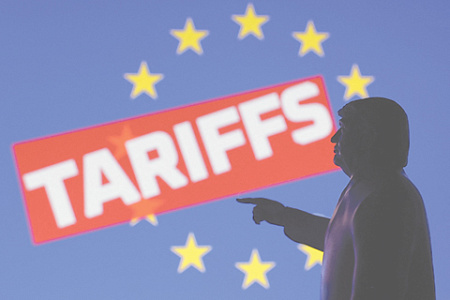
The future of transatlantic trade relations hangs in the balance as crucial talks take place in Scotland between U.S. President Donald Trump and European Commission President Ursula von der Leyen. These high-stakes negotiations could determine whether a full-scale trade war erupts between the two economic giants. President Trump has issued an ultimatum: if a new agreement to rebalance trade is not reached, the U.S. will impose a sweeping 30% tariff on all European Union goods starting August 1st, a move that has many in Brussels skeptical about the chances for a deal, given Trump’s unpredictable negotiating style.
President Trump is combining his vacation at his Scottish golf resort in Thornberry with these pivotal but informal discussions. The relaxed setting is intended to allow for a frank exchange to clarify the final positions of Washington and Brussels without the pressure of signing a formal document. This meeting follows a phone call between the two leaders on July 25th, which von der Leyen described as positive but ultimately inconclusive. Subsequent talks at the ministerial level were reportedly fraught with difficulty, stretching late into the night.
The core of the disagreement is President Trump’s demand that the EU significantly increase its imports of American goods while reducing its own exports to the United States. To enforce this, he threatens to use tariffs, his preferred tool for international disputes. In response, the European Commission has reportedly floated a compromise: a 15% tariff on most EU exports to the U.S., but with exemptions for sensitive products like aircraft and alcoholic beverages. A separate proposal would manage steel and aluminum imports through a quota system, with a steep 50% tariff applied to any shipments that exceed the agreed-upon limits.
Should the negotiations fail to produce an agreement by the August 1st deadline, the European Union is prepared to respond in kind. European Commission spokesperson Olof Gill has clearly stated that Brussels will impose its own tariffs on American imports valued at €93 billion, which would take effect on August 7th. While emphasizing that the EU’s priority is a negotiated solution, Gill noted, “we are preparing for all possible scenarios,” signaling a readiness to engage in a retaliatory economic conflict if necessary.
President Trump’s visit has been met with widespread protests across the United Kingdom. Demonstrators, including both British citizens and visitors from other EU countries, have gathered to voice opposition to a range of his policies, but the primary grievance is his use of economic threats against European allies. This sentiment is strong even in Britain, which has already secured its own trade understanding with Washington. Trump has shown he can reach compromises with close partners like the UK and Japan, but his actions suggest he does not view the EU as a whole in the same light.
This perception was reinforced almost immediately upon his arrival in Scotland. President Trump took the opportunity to lecture European allies, criticizing their investments in renewable energy, such as wind turbines that he claimed “spoil your beautiful fields and valleys and kill your birds,” and urging them to adopt his hardline stance on illegal immigration. By admonishing Europe to follow his lead on domestic policy issues, he set a confrontational tone that does not bode well for a swift and amicable resolution to the pressing trade dispute.
